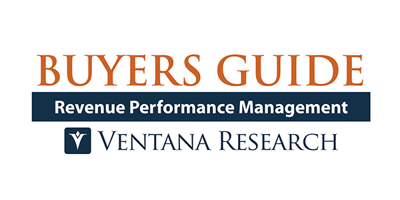Market Observations from the Revenue Performance Management Buyers Guide
Having just completed the 2023 Ventana Research Buyers Guide for Revenue Performance Management, I want to share some of my observations about how the market has advanced since our assessment one year ago.
In many organizations, the sales department is being superseded by revenue teams. These  revenue teams support a super-set of traditional sales functions that include not only those involved in gaining new customers, but also those with an increased focus on customer retention, expansion and cross-sell aimed at existing customers. As organizations embrace additional sales channels, whether through more typical indirect sales from partners or via new digital selling channels like e-commerce, revenue management will require an enhanced degree of alignment and coordination. The economics of multichannel selling and newer business models require the need to expand focus and resources beyond new business. This will impact not just sales and revenue teams but also marketing, partner management, commerce, subscription and customer service.
revenue teams support a super-set of traditional sales functions that include not only those involved in gaining new customers, but also those with an increased focus on customer retention, expansion and cross-sell aimed at existing customers. As organizations embrace additional sales channels, whether through more typical indirect sales from partners or via new digital selling channels like e-commerce, revenue management will require an enhanced degree of alignment and coordination. The economics of multichannel selling and newer business models require the need to expand focus and resources beyond new business. This will impact not just sales and revenue teams but also marketing, partner management, commerce, subscription and customer service.
To achieve these aims, leadership and planning will be key. Any time an organization transitions to new approaches and processes, there will be resistance, missteps and potential disruption. A change in the approach of strategic leadership, and in the planning, monitoring and real-time adjustments via sales or revenue operation teams, is essential. Revenue-driven organizations must manage operations with performance demands in mind and ensure consistent results every quarter, month in and month out. Revenue leaders need to implement processes that support overall strategy and growth, and also optimize both sales professional talent and the selling experience needed to achieve expectations.
The next generation of revenue and sales leaders are embracing the need to focus on creating processes that generate and project predictable revenues. Revenue performance management (RPM) as defined by Ventana Research is a coordinated set of revenue-generating and related activities, processes and systems that enable organizations to plan, execute, monitor and adjust in real time to achieve customer, product and revenue targets. The imperative to maximize outcomes from all channels and departments of revenue faces many challenges in every organization. Key revenue responsibilities across departments that generate new business and client relationships, retain existing ones through potential subscription renewals or upselling, and expand into existing customers are all about setting up revenue efforts in an effective manner. Territories that are balanced, quota and compensation that are aligned with corporate objectives, and reliable forecasts are key to achieving overall goals and outcomes. Sales performance management is a subset of revenue performance management, and this research also assesses what a sales organization needs if they are only focused on a single revenue source.
In addition, new initiatives from technology vendors that use artificial intelligence (AI) and machine learning (ML) that apply to historic data can create new insights to inform both management and revenue-focused professionals. The use of AI can be applied in a variety of different ways, from individual deal scoring to overall pipeline health, customer churn risk prediction and identifying upsell and cross-sell opportunities for existing customers, as well as next-best-action recommendations. All this information can be used to inform revenue forecasts with a greater degree of accuracy and predictability than traditional bottom-up judgement forecasting on its own. And in response to the increased pressure to retain revenue talent, it can be used both to improve individual and teams’ abilities to succeed and to highlight those at risk of leaving.
Ensuring that all buying and selling channels and departments contribute as fully as possible to the success of the organization — to retention, growth, profitability and the overall customer experience — requires not only dedication but effective strategy and planning. A well-developed strategy to utilize current and future talent for sales and revenue efforts is essential for the best possible performance. To carry out this mission, organizations need a set of coordinated revenue-related activities, processes and systems that enable the sales and revenue teams, from leadership and operations to the manager and sellers and customer success, to operate in a coordinated and collaborative manner. The evolution to RPM enables the ability to maximize outcomes across all buying or revenue channels.
Sales and revenue teams are designed to deliver the most effective return on an organization’s products and services across customers or consumers and must ensure that selling is done efficiently and intelligently. Sales and revenue channels and departments are typically complex entities, often with cultures and historical approaches that can inadvertently sabotage their performance. And many in leadership believe that sales teams can adapt and change its behavior without seeking out and using best practices.
In our view, effective management across sales and revenue operations requires well-designed and continuously optimized territories and accounts aligned with quotas that are designed to achieve an organization’s full revenue potential. Territories can be based not only on geographies but on a variety of alternate drivers leading to virtual territories more aligned with current needs. Quotas need to be linked to both overall organization objectives and product and service category targets. With the advent of self-service and digital channels, and as customers can engage across multiple channels for a single purchase, both quotas and territories need to ensure sales individuals are not penalized or disincentivized. This foundation must be established through modeling and planning that will provide the analytics and metrics necessary to guide revenue leadership and operations for the coming month, quarter, year and beyond. To remain flexible and responsive to market conditions, organizations should employ the concept of continuous revenue performance monitoring and adjust territories, quotas and incentives based on data-driven insights and forecasts rather than a whim and gut feeling.
Use of analytics and data from operations and planning can assist in revenue-related compensation plans that utilize commissions and incentives to influence and align behavior and priorities. To optimize revenue performance, organizations must be able to design and apply incentives that motivate those supporting revenue generation to reach their targets. To evaluate whether compensation plans and incentives are effective, revenue leadership needs tools to help assess the relationship between plans, targets and actual performance. Comparing compensation and incentive plans among all revenue personnel and with other parts of the organization, for example, can help managers determine whether what they provide is appropriate. Goals and objectives must be defined, established, tracked and then linked to incentives and rewards to help guide revenue performance. Moreover, organizations need to know whether their compensation is competitive in their market. Using benchmarks to compare compensation to that of others in the industry can provide this information.
Using spreadsheets to manage revenue operations and performance is ineffective and can be problematic when trying to achieve optimal outcomes. Spreadsheets are not designed for managing the data needed across revenue channels or the varying types of buying and selling channels that must be measured toward goals and targets. Spreadsheets also cannot scale as a company grows. The use of multiple spreadsheets, often stored on users’ local drives, is a factor in producing scattered information, which the majority of organizations cite as a major impediment to managing revenue performance. A dedicated approached to RPM can provide a better method to achieve an organization’s goals.
Even revenue-related applications such as sales force automation (SFA) and customer relationship management (CRM) that are designed to capture data about accounts, contacts and opportunities cannot deliver optimal visibility into overall revenue performance in the way that a dedicated RPM system can. Dashboards and reports from SFA systems typically look only at historical performance, but backward-looking reports can’t provide timely guidance on the current state of quotas and incentives for sales professionals and are not flexible enough to provide information on, or credit, others involved in deals.
Our comprehensive evaluation of vendors takes into consideration all the preceding characteristics needed for a revenue performance approach. Revenue performance management systems should deliver functionality and support that enables organizations to plan for and optimize revenue growth across all their relevant teams and channels. Our Buyers Guide report will be of relevance to those organizations who have decided to adopt a revenue performance approach, or who are investigating it.
This research evaluates the following vendors that offer products that address key elements of revenue performance management as we define it: Anaplan, Board International, Oracle, Salesforce, SAP, Varicent Software, Xactly.
You can find more details on our site as well as in the Buyers Guide Market Report.
Regards,
Stephen Hurrell
Authors:

Stephen Hurrell
Director of Research, Office of Revenue
Stephen Hurrell leads the Office of Revenue software research and advisory expertise at Ventana Research, now part of ISG and guides leaders in the applications and technology for buying and selling products and services to maximize revenue. His topics of coverage include digital commerce, partner management, revenue management, sales engagement, revenue performance management and subscription management.










